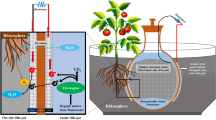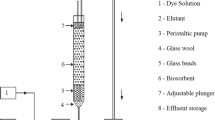Abstract
A stirred vessel coupled with membrane unit containing cellulose acetate (0.45 μm) membrane was used to study the decolorization of anaerobically digested molasses spent wash (MSW). The soil collected from the MSW disposal site was used as inoculum to study the decolorization without addition of any additives. The same inoculum was used over a period of 163 days at room temperature to study the decolorization of 12.5–50% (v/v) MSW using different operational conditions. The reactor was entered in to the inhibition mode after the feeding of 50% MSW, which was restored 100% without changing any operational condition. The maximum decolorization obtained for 12.5% (v/v) MSW was 77.22 ± 0.13%. The decolorization achieved for 25, 37.5, and 50% (v/v) MSW was 70.41 ± 0.12, 56.47 ± 0.17, and 48.78 ± 0.09%, respectively. Increase in the utilization of protein and reducing sugar was observed up to 25% MSW whereas, higher concentration showed decrease in the utilization. Results indicate 63% removal of chemical oxygen demand for 12.5% (v/v) MSW. Membrane flux which was significantly reduced after the feeding of 50% MSW was regenerated without changing the washing procedure, however, 35% decrease in sample flux was observed over the continuous use of membrane for the period of 198 days.






Similar content being viewed by others
References
Adikane HV, Dange MN, Selvakumari K (2006) Optimization of anaerobically digested distillery molasses spent wash decolorization using soil as inoculum in the absence of additional carbon and nitrogen source. Bioresour Technol 97:2131–2135
Chae SR, Shin HS (2007) Characteristics of simultaneous organic and nutrient removal in a pilot-scale vertical submerged membrane bioreactor (VSMBR) treating municipal wastewater at various temperatures. Process Biochem 42:193–198
Chaudhari PK, Mishra IM, Chand S (2008) Effluent treatment for alcohol distillery: catalytic thermal pretreatment (catalytic thermolysis) with energy recovery. Chem Eng J 136:14–24
Dubois M, Gillesk A, Hamilton K, Robers PA, Smith P (1956) Colorimetric method for the determination of sugars and related substances. Anal Chem 28:350–356
Fahy V, FitzGibbon FJ, McMullan G, Singh D, Marchant R (1997) Decolorization of molasses spent wash by Phanerochaete chrysosporium. Biotechnol Lett 19:97–99
Kumar V, Wati L, FitzGibbon FJ, Nigam P, Banat IM, Sing D, Marchant R (1997) Bioremediation and decolorization of anaerobically digested distillery spent wash. Biotechnol Lett 19:311–313
Kumar V, Wati L, Nigam P, Banat IM, Yadav BS, Singh D, Marchant R (1998) Decolorization and biodegradation of anaerobically digested sugarcane molasses spent wash effluent from biomethanation plants by white-rot fungi. Process Biochem 33:83–88
Lee WN, Chang IS, Hwang BK, Park PK, Lee CH, Huang X (2007) Changes in biofilm architecture with addition of membrane fouling reducer in a membrane bioreactor. Process Biochem 42:655–661
Mohana S, Desai C, Madamwar D (2007) Biodegradation and decolourization of anaerobically treated distillery spent wash by a novel bacterial consortium. Bioresour Technol 98:333–339
Mulder M (1996) Basic principles of membrane technology. Springer, New York
Ohmomo S, Kaneko Y, Sirianuntapiboon S, Somchai P, Atthasampunna P, Nakamura I (1987) Decolorization of molasses waste water by a thermophilic strain, Aspergillus fumigatus G-2-6. Agri Biol Chem 51:3339–3346
Singh D, Nigam P (1995) Disposal and treatment of distillery effluent. In: Moo-Young M, Anderson WA, Chakrabarty AM (eds) Environmental biotechnology: principles and applications. Kluwer, Amsterdam, pp 735–750
Trivedy RK, Goel PK (1986) Chemical and biological methods for water pollution studies. Enviro-media, Karad
Wedzicha BL, Kaputo MT (1992) Melanoidins from glucose and glycine: composition, characteristics and reactivity towards sulphite ion. Food Chem 43:359–367
Acknowledgments
We thank the Ministry of Environment & Forests, New Delhi, India (D.O. No. 19-20/2001-RE) for financial support and we are also grateful to Vasantdada Shetkari S·S.K. Ltd, Sangli, India for the supply of molasses spent wash.
Author information
Authors and Affiliations
Corresponding author
Rights and permissions
About this article
Cite this article
Adikane, H.V., Dixit, J.N. Effect of different operational conditions on the decolorization of molasses spent wash using once developed soil inoculum. Biodegradation 20, 867–874 (2009). https://doi.org/10.1007/s10532-009-9274-y
Received:
Accepted:
Published:
Issue Date:
DOI: https://doi.org/10.1007/s10532-009-9274-y




